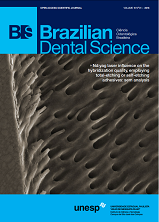A Clinical Report of Functional and Esthetic Oral Rehabilitation in a High-caries-risk Child: One-year follow-up
DOI:
https://doi.org/10.14295/bds.2016.v19i1.1151Abstract
This case discusses a multi-disciplinary approach to oral functional and esthetic rehabilitation on a high-caries-risk child with prematurely lost primary teeth due to endodontic complications associated with wide-spread dental caries. The patient was diagnosed with an anterior open bite and atypical swallowing. He exhibited anxiety and low self-esteem due to esthetic impairment. A combination of targeted clinical procedures, a focus on oral home care and active parental involvement was integral to the treatment process. The patient was examined monthly by a pediatric dentist regarding dietary habits, fluoride exposure, biofilm presence, caries prevalence, and malocclusion. Improvement was evident in patient’s masticatory function, facial esthetics, and psychological behavior at a 12-month follow-up evaluation.
Keywords
Deciduous; Dental Caries; Mouth Rehabilitation; Tooth.
Downloads
Downloads
Published
How to Cite
Issue
Section
License
Brazilian Dental Science uses the Creative Commons (CC-BY 4.0) license, thus preserving the integrity of articles in an open access environment. The journal allows the author to retain publishing rights without restrictions.
=================




























